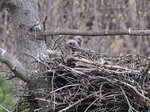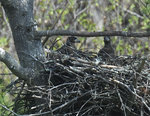In the early 2000s, when I first started tracking bald eagle nests in the upper Delaware River corridor, there were about 10 nests between Port Jervis, NY and Hancock, NY. This was an encouraging …
Stay informed about your community and support local independent journalism.
Subscribe to The River Reporter today. click here
This item is available in full to subscribers.
Please log in to continue |


In the early 2000s, when I first started tracking bald eagle nests in the upper Delaware River corridor, there were about 10 nests between Port Jervis, NY and Hancock, NY. This was an encouraging number for 73 miles of river. Due to the effects of the chemical dichlorodiphenyltrichloroethane (DDT) that was used before it was banned, eagles and other raptors could not reproduce. By 1970, the non-migrant eagle population of both New York and Pennsylvania was down to a couple of non-reproducing pairs. In 1980, New York started a large-scale eagle re-introduction effort; Pennsylvania followed up with its own effort a couple of years later. The young eagles used in this project came from Alaska and other areas where DDT was not used.
The majority of introduced eagles were able to survive their first 5 years and become sexually mature; they started to establish territories and fledge young. The first occupied pair appeared in 1993 along the river corridor, followed by another pair two years later. Twenty years after the first pair appeared on the main stem of the Delaware River, there were 19 pairs breeding in the river corridor. At the moment, there are 21 known territories along this 73-mile stretch of the river.
Eagles are very territorial and will defend their nests against predators and other raptors, and that includes other eagles. Eagles will chase off other immature or adults that venture too close to the nest. Sometimes, fights occur, frequently resulting in injury or even death to an eagle involved. For this reason, we may not see the population rise that we’ve seen in past years; breeding pairs are less than a mile apart in some cases, and that seems to be the limit of tolerance at the present time along the Upper Delaware corridor.
If you happen to spot a nest, keep your distance to avoid disturbing the eagles. (And you won’t be able to see much getting too close; the nests are 90 feet high, and you won’t see anything looking up). Across the river works better, as you are far enough away to see across the nest and see the battleship-gray down-covered young. For most region nests, young are now growing rapidly and feathers are starting to appear. By mid-June, the young will be close to full size (as large as the adults), and they will start fledging at the end of June or early July. You may be able to see these newly fledged eagles as you paddle down the river, perhaps as they have mock dog fights and display talons with their siblings while they improve their flying skills. Enjoy.
Comments
No comments on this item Please log in to comment by clicking here